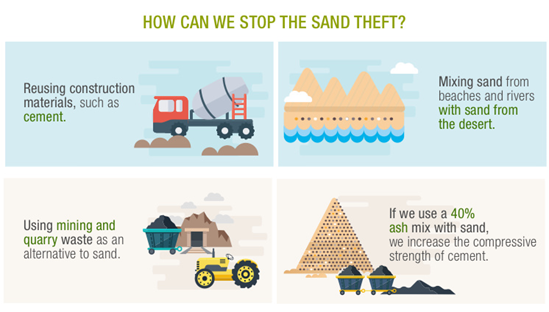

10th September 2022 (6 Topics)
Context
Recently, sand mining has attracted attention in Haryana’s part of Yamuna stretch.
- Sand Mining and Human activities near River has deteriorated its health and is threat to the river’s Biodiversity.
Background
- Sand mining is a pan-India problem.
- It is prevalent in the Garo Hills in Meghalaya, the Sutlej in Punjab, Yamuna in Delhi, the Ganga in Haridwar, Urmil and Betwa in Bundelkhand, Kosi in Bihar, the Chambal and Narmada in Madhya Pradesh, Ojat in Gujarat, the Subarnarekha in Odisha, Musi in Telangana, Netravati and Phalguni rivers in Karnataka, Godavari and Krishna in Andhra Pradesh, and Cauvery in Tamil Nadu.
|
UNEP in its report ‘Sand and Sustainability’ highlighted that the demand for sand has increased three-fold over the last decades, driven by shifting consumption patterns, growing populations, increasing urbanisation and rapid infrastructure development. |
Sand and its Geology
- Sand is a granular material composed of finely divided rock and mineral.
- Composition of sand is highly variable, depending on the local rock sources and conditions, but the most common constituent of sand in inland continental settings and non-tropical coastal settings is silica (silicon dioxide, or SiO2), usually in the form of
- Sand is classified as a “minor mineral”, as per The Mines and Minerals (Development and Regulations) Act, 1957 (MMDR Act).
- Sand mining is the extraction of sand, mainly through an open pit (or sand pit) but sometimes mined from beaches and inland dunes or dredged from ocean and river beds.
Provisions for regulating Sand Mining in India
- State Governments have made different rules for awarding, regulating and administering the sand concessions.
- To curb Illegal mining, there have been various judicial interventions by the Supreme Court (SC) and National Green Tribunal (NGT).
- The National Green Tribunal in August 2013 passed an order banning sand mining without proper environment clearance.
- The Ministry of Environment, Forest and Climate Change (MoEFCC) has released “Sustainable Sand Mining Management Guidelines 2016” to promote scientific mining of sand and encourage environmental friendly management practices.
- Ministry of Mines has also developed a Mining Surveillance System (MSS) to use space technology for facilitating State governments in curbing illegal mining activities in the country.
- Under Sections 120B read with Section 34 of Indian Penal Code, 1860, extraction of sand without a legal permit is a ‘punishable offence’.
Why it should be regulated?
- Alteration of Rivers: Excessive sand mining can alter the river bed, force the river to change course, erode banks and lead to flooding.
- Damage River Biodiversity: In stream mining can have other costly effects beyond the immediate mine sites. Many hectares of fertile streamside land are lost annually, as well as valuable timber resources and wildlife habitats in the riparian areas.
- Degraded stream habitats result in loss of fisheries productivity, biodiversity, and recreational potential.
- Alter Sediment Budget: As the amount of sand reaching Oceans changes, rivers are not able to replenish the sand on beaches and in deltas.


